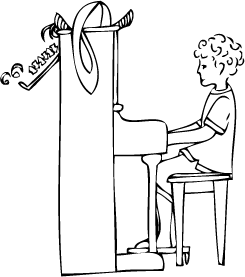 Australian. A new series of 3 progressive books written by Australian pianist and composer Adam Pinto.
Australian. A new series of 3 progressive books written by Australian pianist and composer Adam Pinto.
Well-known tunes. Through playing children's songs, nursery rhymes & folk tunes students are able to progress rapidly and with a great sense of achievement.
Large print, half size book. Easy to read larger print size with a half sized books 1 & 2 that are easy to carry for young students. Book 1 has 48 pages, book 2 has 64 pages and books 3 has 48 oversized pages.
Solid technical foundation. A progressive development of finger independence, leading to a standard yet flexible concept of hand position. In book 3 flexible hand positions are developed with progressive tunes to gently increase the reach of each hand while shifting hand positions use a wider range of the keyboard. Correct fingerings for scales are learned followed by relevant repertoire in the same key. Develop coordination and independence of the hands.
Basic musical concepts. A gentle introduction to music including simple time, contrasting dynamics, Italian words and basic rhythms. Book 2 continues with compound time, graduated dynamics, more Italian words and simple rhythms. Book 3 adds more dynamics, musical terms, new notes and key signatures.
Teach in your own way. These books include basic theory and give direction to students yet allow teachers to teach in their own unique way.
Duet Parts. In books 1 & 2 fun, simple accompaniments for the teacher to reinforce rhythmic and ensemble skills.
Improvisation & composition. Enhance the students imagination with short tasks to exercise their creativity.
Complete glossary. A quick reference guide to the musical concepts introduced in the book.
Preparation for music exams. Progress through the 3 books allows for thorough preparation for a students first music exam.
Learning through questions. The use of questions & answers encourage students to remember concepts.
Video demonstrations. Available online, download free video demonstrations of many of the tunes and excercises from book 1, all played by pianist Adam Pinto.
Background
One of the guiding concepts behind the material used in the tutor books was that it should be well known and loved by students, especially young children. Nothing is worse than seeing a young child give up music because they “don’t like the tunes”. One of the reasons we learn music is to play the repertoire we love. Teaching children to play the music they know makes the comprehension and realisation of rhythm and theory much simpler. Therefore, the tunes used in the books are your favourite children’s tunes, nursery rhymes, anthems and famous classical themes.
Clear Layout
 Another basic idea in the books is to provide a simple layout and guide. The basic techniques are stressed but the books still allow flexibility for the individual style and method of most teachers. For this reason the tunes have been presented in a simple manner, without excess clutter on each page. The books have been designed to be relevant to the way in which music is talked about and taught in Australia. There is a progressive line up of pieces, but especially in book three, with the possibility of using the tunes in a more flexible order as the students’ technique and confidence develops.
Another basic idea in the books is to provide a simple layout and guide. The basic techniques are stressed but the books still allow flexibility for the individual style and method of most teachers. For this reason the tunes have been presented in a simple manner, without excess clutter on each page. The books have been designed to be relevant to the way in which music is talked about and taught in Australia. There is a progressive line up of pieces, but especially in book three, with the possibility of using the tunes in a more flexible order as the students’ technique and confidence develops.
One of the most challenging aspects of putting together a tutor book series such as this is ensuring that all the musical concepts, practical techniques and theoretical knowledge flows in an orderly and logical way. You can’t have a tune using a note or technique that hasn’t been explained or developed gradually in some way before.
Book 1
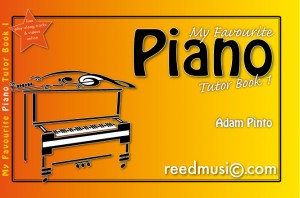 The first book is concerned with basic theory & teachnique. It introduces simple time signatures like 4/4 and 3/4and the basic rhythmic values of notes such as semibreves, minims, crotchets, quavers and rests. This is aimed at developing a technical ability in simple rhythm and basic reading skills. The development of finger strength and independence, with a degree of flexibility is also a key feature of the book. With only a brief introduction to pre-reading, in order to get a taste of linear/intervallic reading, the book quickly moves on to the tunes being presented on the grand staff as we expect to see piano music. Right from the beginning the books are aimed at getting students to read and learn notes as they appear on the Grand Staff, not fingerings. This creates flexibility in the students hand position. It also makes simple left hand tunes easier to learn, as the fourth and fifth fingers can be introduced gradually as a greater range of notes are learnt through the tutor book. For this reason the books contain only the essential fingerings, as more can be entered by student and teacher depending on individual requirements.
The first book is concerned with basic theory & teachnique. It introduces simple time signatures like 4/4 and 3/4and the basic rhythmic values of notes such as semibreves, minims, crotchets, quavers and rests. This is aimed at developing a technical ability in simple rhythm and basic reading skills. The development of finger strength and independence, with a degree of flexibility is also a key feature of the book. With only a brief introduction to pre-reading, in order to get a taste of linear/intervallic reading, the book quickly moves on to the tunes being presented on the grand staff as we expect to see piano music. Right from the beginning the books are aimed at getting students to read and learn notes as they appear on the Grand Staff, not fingerings. This creates flexibility in the students hand position. It also makes simple left hand tunes easier to learn, as the fourth and fifth fingers can be introduced gradually as a greater range of notes are learnt through the tutor book. For this reason the books contain only the essential fingerings, as more can be entered by student and teacher depending on individual requirements.
Book 2
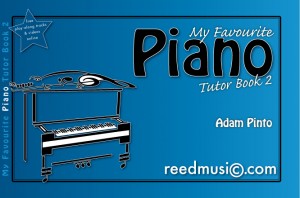 The second book extends the basic rhythmic concepts up to and including the use of semiquavers, triplets and the 6/8 time signature. Reading skills are extended, covering all the notes on the Grand Staff. Variation in touch is introduced with tunes making use of legato and staccato, and the second book also introduces the basic technique required for independence between the hands.
The second book extends the basic rhythmic concepts up to and including the use of semiquavers, triplets and the 6/8 time signature. Reading skills are extended, covering all the notes on the Grand Staff. Variation in touch is introduced with tunes making use of legato and staccato, and the second book also introduces the basic technique required for independence between the hands.
Book one and two contain composition exercises, as writing is a key to learning, and improvisation exercises to encourage creativity and experimentation with the techniques and notes learnt. The first two books include accompaniment parts for nearly all the tunes to make it as easy as possible for teachers to play along with their students. This will instil solid rhythmic skills as well as increase the enjoyment of lessons for all involved.
Book 3
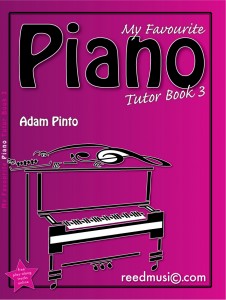 This leads to book three, which is aimed mainly at extending the students technique, and any associated theory. In the third book there is a gentle stretching of the hands to larger positions, including theory about the intervals themselves. It introduces the changing of hand positions whilst playing. The left hand begins to be used as an accompanying hand and thus the student begins playing with a concept of texture and balance. Scales are introduced when they are related to the tunes themselves. Book three also introduces canon playing for an even greater control of independence between the hands. The canons in the book come with preparatory pieces to give students a practical understanding of practice techniques. Some tunes are arranged for piano four hands in order to allow students to practice and perform with other students of the same proficiency, not just in duet with their teacher. (It is more fun playing music with others than on your own!)
This leads to book three, which is aimed mainly at extending the students technique, and any associated theory. In the third book there is a gentle stretching of the hands to larger positions, including theory about the intervals themselves. It introduces the changing of hand positions whilst playing. The left hand begins to be used as an accompanying hand and thus the student begins playing with a concept of texture and balance. Scales are introduced when they are related to the tunes themselves. Book three also introduces canon playing for an even greater control of independence between the hands. The canons in the book come with preparatory pieces to give students a practical understanding of practice techniques. Some tunes are arranged for piano four hands in order to allow students to practice and perform with other students of the same proficiency, not just in duet with their teacher. (It is more fun playing music with others than on your own!)
Illustrations
For fun, for colouring in, the large illustrations in books 1 & 2 have been drawn by Kristie Pinto.
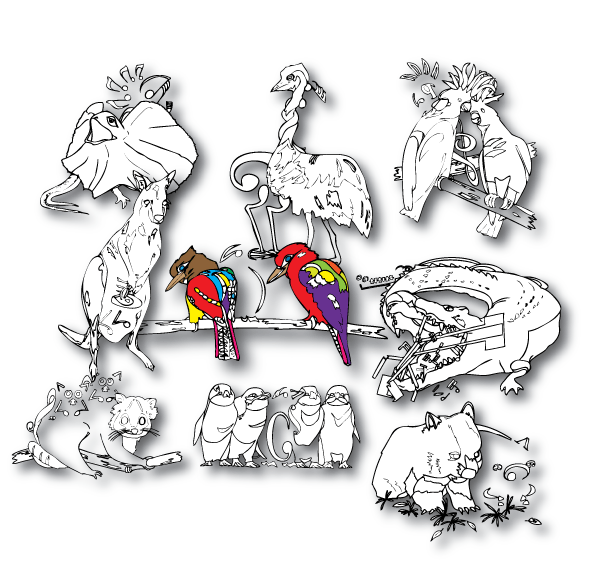
Meet Adam Pinto
From September to December in 2007 I spent three months as a resident at the Banff Centre for the Arts in Canada. This allowed me time to practise, rehearse and perform on a scale which is impossible in normal, everyday life. The creation of these tutor books has been something that has been developing over some time and this residency in Banff gave me the opportunity to see my ideas through. I am lucky enough to have a supportive wife and together we have three beautiful children, the eldest of whom became a guinea pig for the first and second of the piano tutor books I have been compiling.
The first part of the process had been pretty much completed before arriving in Banff. The tunes had been chosen, arrangements made and a basic order decided. Because many of the tunes were chosen simply because they were well known, some were easy to arrange and fit well into the progressive development of the piano tutor. Others were more difficult and needed a great deal of transposition and re-arranging in order to create simple, yet interesting versions.
Basic theory is introduced where appropriate and is constantly revised throughout the books with the use of questions on most pages about the tunes being learnt. Thus concepts are introduced and then quickly re-enforced without too much time to forget things in between. The glo
ssary is always available as a reference for any of the words or theoretical information used in the books.
These books are aimed at helping students reach the requirements to sit their first exams and give confident performances. The technique, theory and general knowledge covered gives a basic grounding in what is required at a preliminary level. Adam Pinto

